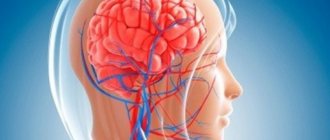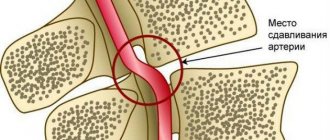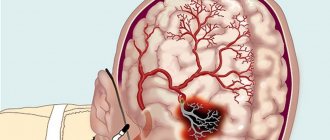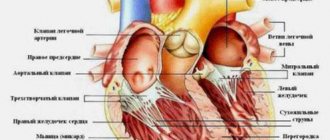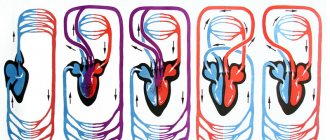01.11.2017
Interesting
Bogacheva Sharofat Bairovna
The brain is a “mystical” organ that can fill us with incredible sensations, show us our own “movie”, dreams, accumulate experience and wisdom that allows us to think. This is an organ that controls and regulates the functioning of the entire organism as a whole and each organ and system separately; providing the balance, protection, and compensatory reactions to disturbances necessary for our body. This small organ, weighing about 1400–1500 g (2% of body weight), has incredible abilities that have not yet been fully studied.
What does the brain need? Working without rest day and night, he is in dire need of oxygen (the brain consumes 20% of all oxygen entering the body) and nutrients, without which he cannot live even for a few minutes. It is a known fact that oxygen reserves are not created in the brain, and there are no substances that can nourish it under anaerobic (in the absence of oxygen) conditions. That is, the nerve cells of the brain constantly need oxygen, glucose and “cleaning” (cleansing of cell waste products).
Excursion into physiology
The uninterrupted supply of substances necessary for the nerve cells of the brain and the cleansing of waste are carried out by the cerebral circulatory system, where arterial blood carries oxygen and nutrition to the brain, and venous blood removes toxins and metabolic products.
The vessels of the brain have a unique, perfect structure that ideally regulates blood flow, ensuring its stability. They are designed in such a way that with an increased flow of blood into large vessels, the strong pulse impulse of the blood coming from the heart is weakened due to numerous bends (siphons) of the vessels along the vascular bed, which contribute to the pressure drop and smoothing of the pulsating blood flow. Due to complex regulatory mechanisms, when total blood pressure increases, the pressure in the brain remains stable for a long time. Regulatory systems allow blood flow to be redistributed from parts of the brain with less load to areas with increased brain activity.
The brain has an autonomous regulatory system, which allows it to be in a healthy functional state and control the processes of continuous adaptation of the body to constantly changing conditions of the external and internal environment. In a state of functional rest, the brain receives 750 ml of blood per minute, which is 15% of cardiac output. In children, blood flow activity is 50–55% higher, and in elderly people it is 20% lower than in adults.
It should be noted that the gray matter of the brain (cell bodies of neurons) is supplied with blood more intensively than the white matter (conducting pathways), which is due to greater cell activity. Thus, during intense mental work, local blood flow in the cerebral cortex can increase 2–3 times compared to the resting state.
The brain has the richest capillary network. Nerve cells are not only intertwined, but also penetrated by capillaries. The vessels of the brain are connected to each other by collaterals (“bridges”). Arterial collateral circulation of the brain, important for maintaining normal blood flow, plays a particularly significant role in compensating for circulatory disorders when one of the cerebral arteries is blocked.
With a high intensity of blood flow in the vessels of the brain, the blood pressure in them is maintained relatively constant. A complex chain of regulatory mechanisms protects the brain from a drop in blood pressure and hypoxia (decreased oxygen). Along the path of blood flow to the brain, there are many sensitive cells (pressoreceptors, chemoreceptors) that can respond to blood pressure and regulate heart rhythm and vascular tone.
The activity of the vasomotor centers of the brain is associated not only with nervous and humoral regulation mechanisms, but also with the autonomic regulation system, which allows, despite significant fluctuations in total blood pressure, to maintain cerebral blood flow at a constant level.
Thus, cerebral circulation is provided with complex regulatory mechanisms that make it possible to maintain a constant supply of the substances it needs.
With excessive blood supply to the brain, excessive hydration (fluid accumulation) may occur, followed by the development of edema and damage to vital centers that are incompatible with life. The cause of excess blood supply can be, for example, an increase in systemic blood pressure to 160–170 mm Hg. Art. and higher.
In the problem of impaired blood supply to the brain, much attention is paid to arteries. But venous circulation is no less important. The veins carry out the removal of waste substances (toxins) with the blood - that is, cleansing the brain. Thanks to these vessels, constant intracranial pressure is maintained.
Violation of the venous outflow leads to stagnation of blood and accumulation of fluid in the brain, causes hydrocephalus with compression of the brain centers, and contributes to the occurrence of phlebitis and thrombophlebitis.
There is one more feature of the cerebral veins that must be taken into account. The wall of a venous vessel in the brain does not have a valve apparatus, unlike, for example, the veins of the extremities (valves help withstand loads by moving blood upward and preventing it from moving in the opposite direction). Therefore, venous blood in the vessels of the brain passes freely in both directions, depending on the pressure that arises. This creates a danger of rapid spread of infection from the sinuses and eye sockets, which is facilitated by the atomic structure of the nose and its paranasal sinuses, located in close proximity to the brain. When coughing, venous pressure increases, reverse venous flow, congestion, and brain hypoxia become possible. There are known cases of loss of consciousness during a coughing attack in the presence of a chronic respiratory tract disease and in young children when they “go into a fit” of coughing during illness and crying and screaming until they cough.
It becomes clear why long-term respiratory problems, accompanied by constant swelling and coughing, can cause cerebrovascular accidents. Because they not only cause brain hypoxia, but also disrupt venous outflow and, being a constant source of infection, contribute to its penetration into the brain.
An ophthalmologist, for example, can observe manifestations of congestion in the brain (dilated, blood-filled vessels of the fundus). But this is also visible to the naked eye: red, puffy eyes after sleep (due to drinking alcohol the night before, overeating at night, lack of sleep) are a symptom of congestion in the brain.
After a brief excursion into physiology, it becomes clear that the reasons for the deterioration of cerebral circulation may be associated with disturbances in the flow of blood to the brain and the outflow of blood from the brain.
Circulation circles
What is the circulatory system in the body? The largest artery is the aorta, into which blood is pushed under high pressure from the left ventricle. Further movement occurs through arteries, capillaries and veins. Large vessels in organs branch into smaller and microscopically thin ones. The capillaries then enlarge and gather into veins.
Table "Blood circulation"
| Circles | Big | Small |
| Where does it begin | In the left ventricle | In the right ventricle |
| Where does it end? | In the right atrium | In the left atrium |
| Oxygen content | Decreases as oxyhemoglobin releases O2 and binds CO2 | It increases because in the alveoli of the lungs carboxyhemoglobin releases CO2 and binds O2 |
| Importance for the body | Delivers O2, nutritional and mineral elements, hormones, vitamins to cells | Removal of CO2 for removal from the body into the environment, enrichment of blood with O2 |
Small veins enlarge and join the vena cava, which flows into the right atrium. As a result of its contraction, blood enters the right ventricle. The pulmonary artery emerges from it, carrying venous blood. The pulmonary veins carry arterial blood into the left atrium.
Functions of the circulatory organs:
- Providing cells with nutrition, hormones, vitamins, oxygen, water, organic and inorganic ions.
- Maintaining a constant temperature and other important parameters of the body.
- Removing CO2 and unnecessary metabolic products from cells.
- Participation in humoral regulation.
- Carrying out gas exchange.
The average volume of blood in the human body is from 4 to 6 liters. Arterial blood makes up 20%, venous blood - up to 80% of the total volume. Half does not participate in the bloodstream, but is located in the blood depot: liver, spleen, abdominal veins. The supply quickly replenishes and increases the mass of circulating blood in critical situations.
See also: What are the causes of cardiovascular diseases and what are the prerequisites?
What happens when blood pressure rises?
At first, vascular tone is slowly disrupted. Over time, if elevated blood pressure (BP) persists, minor cerebral hemorrhages and strokes may occur.
As a result of a constant increase in blood pressure during hypertension, plasma (part of the blood without formed elements) is released, which ultimately leads to the destruction of the walls of blood vessels.
How does this happen? A specific protein (hyaline-like substance, similar in structure to cartilage) is deposited on the walls of blood vessels, which leads to the development of hyalinosis. The vessels become like glass tubes, lose their elasticity and ability to hold blood pressure. In addition, the permeability of the vascular wall increases, and blood can freely pass through it, soaking the nerve fibers (diapedetic bleeding). The result of such transformations can be the formation of microaneurysms and rupture of the vessel with hemorrhage and blood entering the white medulla. The resulting swelling and hematomas lead to further hemorrhages (hemorrhagic stroke).
Atherosclerosis that accompanies hypertension, or exists without it (which is rare), contributes to cerebral ischemia - insufficient supply of nutrients and oxygen to the tissues (except for atherosclerotic plaques that narrow the lumen of the arteries, the blood itself can be thick and viscous).
Acute circulatory disorders are strokes (hemorrhagic and ischemic). But it all starts with transient cerebrovascular accidents against the background of hypertension and atherosclerosis, as well as obesity, diabetes mellitus, and respiratory diseases that often accompany them.
Symptoms of cerebrovascular accident
When a lesion forms in the brain with impaired blood supply, the patient may experience numbness in half of the body (on the side opposite to the lesion) and part of the face around the lips; short-term paresis of the limbs or other parts of the body and face is possible. Speech is impaired and an epileptic seizure may occur.
If there is a circulatory disorder, depending on the location of the lesion, the legs and arms may become weak, the head may become dizzy, the patient may have difficulty swallowing and pronouncing sounds, photopsia (appearance of luminous spots, sparks, etc. in the eyes) or diplopia (doubling of visible objects) may occur. . The person loses orientation and has memory lapses.
Signs of impaired cerebral circulation due to hypertension are manifested in the following: the head and eyeballs begin to hurt very much, the person experiences drowsiness, he experiences stuffiness in the ears (like on an airplane during takeoff or landing) and attacks of nausea. The face turns red and sweating increases.
Unlike strokes, all these symptoms, which are called “transient attacks,” disappear within 24 hours.
Chronic cerebrovascular accident (CVA), unlike acute forms, develops gradually. There are three stages of the disease:
- At the first stage, the symptoms are vague. They are more like chronic fatigue syndrome. A person quickly gets tired, becomes hot-tempered and absent-minded, and forgets some minor points. His sleep is disturbed, his mood often changes, his head hurts and he feels dizzy.
- At the second stage, chronic cerebrovascular accident is accompanied by significant memory deterioration, and minor motor dysfunctions develop, causing unsteadiness in gait. There is a constant noise in my head. A person perceives information poorly, having difficulty concentrating his attention on it. Becomes irritable and unconfident, loses intelligence, reacts inadequately to criticism, and often becomes depressed. He gradually degrades as a person and adapts poorly socially. He constantly feels dizzy and has a headache. He always wants to sleep. Performance is significantly reduced.
- In the third stage, all symptoms intensify. Personality degradation turns into dementia, memory suffers. Having left home alone, such a person will never find his way back. Motor functions are impaired, which manifests itself in hand tremors and stiffness of movements. Speech impairment and uncoordinated movements are noticeable.
Historical reference
In the past, when scientists did not yet have informative instruments at hand that could study physiological processes in a living organism, the greatest scientists were forced to search for anatomical features in corpses. Naturally, the heart of a deceased person does not contract, so some nuances had to be figured out on their own, and sometimes simply fantasized. Thus, back in the second century AD, Claudius Galen, studying from the works of Hippocrates himself, assumed that the arteries contained air instead of blood in their lumen. Over the next centuries, many attempts were made to combine and link together the existing anatomical data from the standpoint of physiology. All scientists knew and understood how the circulatory system works, but how does it work?
Miguel Servetus and William Harvey made a tremendous contribution to the systematization of data on the work of the heart in the 16th century. Harvey, the scientist who first described the systemic and pulmonary circulation , in 1616 determined the presence of two circles, but he could not explain in his works how the arterial and venous beds were connected. And only later, in the 17th century, Marcello Malpighi, one of the first to use a microscope in his practice, discovered and described the presence of tiny capillaries, invisible to the naked eye, which serve as a connecting link in the blood circulation.
Consequences of cerebrovascular accidents
Disability is a sad result of acute and in many cases chronic cerebrovascular accident.
Acute cerebrovascular accident has serious consequences. In most cases, a person who has suffered a stroke becomes completely helpless. He cannot eat, perform hygiene procedures, dress, etc. on his own. Such people have a completely impaired ability to think. They lose track of time and have absolutely no orientation in space.
Some people retain the ability to move. But many people, after a cerebrovascular accident, remain bedridden forever. Many of them maintain a clear mind, understand what is happening around them, but are speechless and cannot express their desires and feelings in words.

